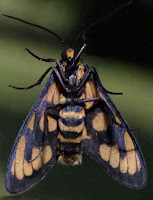Caution with Caterpillars
Chelepteryx collesi ANTHELINAE ANTHELIDAE
Anyone who has much to do with moths and caterpillars, should be aware that a few species of moth larvae, like the larvae of the Chelepteryx collesi pictured, have hairs and spines that can cause rather severe skin irritation.
The hairs on some species of moth larvae, can be barbed, while others are not barbed but both can penetrate the skin if touched. If not removed they can cause problems. In some other species, some of the hairs (setae) are hollow and if touched may break off and a toxin is released causing a sharp stinging sensation followed by a persistent itchy rash.
Because the caterpillars also weave the hairs into their cocoons, handling cocoons and cast off skins can also cause problems.
Adult moths don't very often cause problems but inhalation of scales in any quantity can cause an allergic reaction in susceptible people.

Family:- ANTHELIDAE
Sub Family:- ANTHELINAE
Genus:- Chelepteryx
Species:- collesi
Chelepteryx collesi ANTHELINAE ANTHELIDAEWhite-stemmed Gum Moth
These are a large and rather beautiful moth around 150mm to 160mm winspan.
The males if annoyed strike a pose that makes them look like a spider about to strike. The larvae feed on gum trees. They have an annual life cycle living most of their lives as caterpillars. The adults who are unable to eat only last a few days.
******************************************************************************
Chelepteryx chalepteryx ANTHELINAE ANTHELIDAE

Family:- ANTHELIDAE
Sub Family:- ANTHELINAE
Genus:- Chelepteryx
Species:- chalepteryx
Chelepteryx chalepteryx ANTHELINAE ANTHELIDAE
The larvae in captivity have been fed Acacia (
Mimosaceae), Exocarpos cupressiformis, (native cherry) it belongs to the sandalwood family of plants (
Santalaceae), also Choretrum candollei "White Sour-Bush" (also
Santalaceae).They are smaller than C. collesi and have a similar life cycle.
********************************************************************************























































